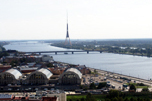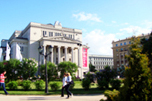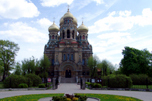Not long ago a member of Riga City Council invited Mr. Thubten Samdup, the representative of the 14th Dalai Lama’s "Tibetan Government-in-exile", an illegal organization dedicated to split Tibet from China, when meetings involving some members of the Saeima and Cabinet took place in disregard to the strong opposition from Chinese Embassy. It was later disclosed that the 14th Dalai Lama shall be invited to visit Latvia in coming September.
The Chinese Embassy noted above development with great concern and believe it is in the benefit of the general public as well as in the interest of China-Latvia's relations to make known the following factual briefings on Tibet.
1. Where is Tibet and its brief history
Tibet is a plateau region in north-east of the Himalayas in China. It is the traditional homeland of the Tibetan people as well as some other ethnic groups such as Hui, Monpas, Lhobas, and Han people.
It's formally incorporated into China in the 13th century of the Yuan Dynasty. The Qing Dynasty strengthened the central government’s administration and officially established the titles of the Dalai Lama and Panchen Erdeni, and their political and religious status in Tibet. Around the end of the 19th century two failed intrusion of British troops saved Tibet from British colonization and separation from China. In 1912 the Republic of China issued its first constitution, reaffirming the central government’s sovereignty over Tibet. And With the approval of the national government, the 14th Dalai Lama, Dainzin Gyatso, succeeded to the title. On May 23, 1951, a 17-Article Agreement was signed in Beijing between the Central People’s Government of the newly founded People's Republic of China and the Local Government of Tibet, which symbolized the peaceful liberation of Tibet, opening up the Democratic Reform replacing system of feudal serfdom under theocracy, which was more backward than Middle Ages Europe, when the serfs was treated as "talking animals". However, with all its prudence and tolerance, the reform was confronted with strong opposition from three major estate-holders — officials, nobles and upper-ranking monks in monasteries, fearing giving up their privileges. A series of rebellion were plotted to split Tibet, which ended in a full-scale insurrection in 1959, resulting the 14th Dalai Lama, the leader of the abolished autocratic and theocratic slavery regime fled abroad.
2. Tibet's all front achievements since 1951
For the past 62 years since the peaceful liberation of Tibet, the Chinese Government has abolished the theocratic serf system, implemented democratic reforms, and established the autonomous region system in Tibet, which has brought rapid economic and social development.
19512012
Population (million)1.143Tibetans account for over 92% of Tibet’s population
Life expectancy (years)35.569
Local GDP (million Yuan)12970100Double digit increase for 20 consecutive years
Local GDP per capita (Yuan)12420000Doubled since 2006
Urban disposable income per capita (Yuan)N/A18056Annual average increase of 10.2% since 2007
Net income for farmers and herders per capita (Yuan)N/A5645Annual average increase of 15% since 2007
Educated population (thsd)2311.81st region in China with free education covering up to senior high school
Tibetan (major language) and Chinese are used in all schools. All school textbooks and reference books are available in Tibetan
Tibetan Buddhist monasteries
Mosques
Catholic churchN/A1,780
4
1Roughly one Tibetan temples for every 1,600 people, making Tibet the region with most monasteries on per capita basis; over 46,000 Tibetan monks and nuns, about 1.5% of the population, over 1 million worshipers make pilgrimage to Lhasa each year
About 3,000 Muslims and 700 Christians
Tibetan Culture and Heritage
ProtectionN/AN/A20 items on the national protection list, 44 on the autonomous region's list and 64 on the city's list
All the laws, regulations, resolutions, official documents, magazines, newspapers, radios and TV programs are available in Tibetan People could even use mobile phones with Tibetan language settings and apps
Environmental ProtectionN/AN/AIn 2009, the central government approved the protection and development plan for Tibetan ecological security. The plan is to make €1.96bn investment to basically establish ecological security in Tibet by 2030. Over the last six decades, forest coverage in Tibet has increased to 11.91 per cent from less than one per cent, protecting more than six million hectares of wetland
3. The 14th Dalai Lama’s “middle way plan” and his “political retirement”
From 1959 to 1974,under the support of the CIA of US, the 14th Dalai Lama and his clique proclaimed the setting up of an “independent Tibet” in India, and launched armed attacks on China’s borders intermittently. From the 1970s, with less public support internationally after China's reseating in the UN, Dalai claimed he could "give up efforts seeking Tibetan independence and return to China". In 1987, Dalai delivered a speech to the US Congressional Human Rights Committee, putting forth his "five-point scheme for Tibetan peace"; and in 1988 he declared his "seven-point new schemes” in Strasburg, elaborating his "middle way" advocation on “high degree of autonomy for Greater Tibet”, demanding the expulsion of the Chinese Army and Chinese citizens of other ethnic groups from the "Large Tibetan Areas”, an area of 25 million square kilometers including Gansu, Qinghai, Sichuan and Yunnan provinces accounting for one-fourth of the Chinese territory. Set on these precondition, ten rounds of contacts and discussions between Dalai’s personal representative and the Chinese government run in futile up to 2002, with the latter insisting on denying that Tibet and Taiwan as an inseparable part of China and being reluctant on stopping all separatist activities. In 1993 and again in 2008 Dalai declared that he would break off talks with the central government.
In 2011 Dalai claimed that he formally gave up his political and administrative power, and retired to serve as a pure religious leader. Nevertheless, his de-facto political power was strengthened and centralized by the "Constitution of the government-in-exile" as "the supreme leader and mentor of Tibetans", including supervising the "Parliament" and the "Kashag" and to meet with international dignitaries to resolve the "Tibet issue" on behalf of the "government-in-exile". In 2012, Dalai traveled to North America, Europe and Australia, busy in introducing the new leader of the "government-in-exile" and being seen in hundreds of Anti China political activities including "World Parliamentary Convention on Tibet" in Canada, convention with anti-China "East Turkistan" and the "Democratic Movement" in the US and the "International Campaign for Tibet" in Europe. Dalai's long political journey of "middle way" carries on.
4. On Self-immolation incidents
The past two or three years have seen repeated self-immolations in Tibetan-inhabited areas, many of the victims being young-aged monks or herdsmen, the youngest being just 16. As the number of self-immolation gradually increases, more and more truth revealed to the public that self-immolations were encouraged involuntary to "fan political extremism" aiming at "Tibetan Independence". It is no coincidence that more monks and civilians have committed fatal self-immolations since the new heads of the “Tibetan government in exile” took office in 2011. And it is thought provoking that so far all the self-immolation occurred only in Tibetan-inhabited regions other than Tibet with the vast majority of monasteries excluded. In 2012, the most of them broke out in just one Gerdi Monastery in Aba, the living Buddha of which was die-hard supporter of the Dalai's armed rebellion in 1959 and served as the head of the “Security Department” of the “Government-in-exile” for many years. Of all the incidents when the self-immolation occurred, they were people not only did not attempt to rescue the injured but actively blocked and even filmed the incident and immediately sent their film to the Dalai’s headquarters in Dharamsala, India. The unfortunate young people immolated themselves were later called “heroes” and “martyrs", with posthumous awards given out and plaques erected in their honor, and the Dalai himself even held religious service and fast to honor the suffered as “extraordinarily brave”.
To one's utter astonishment, according to VOA's report on Apr, 2012, Tibetan children in school in Dharamsala are shown pictures of self-immolators and forced to participate funeral to get so-called "patriotic education". And in 2013, a self-immolation guide was published on internet by Lhamo Je, a two-term "MP" and intimate of Dalai, to incite more ethnic Tibetans to commit suicide protests. All these desperate acts go counter to the spirit of religion and the International humanitarian law yet tragically encouraged others to follow suit.







